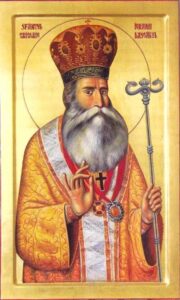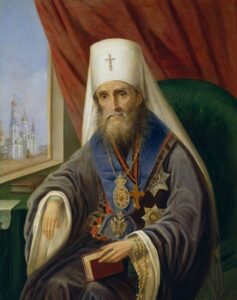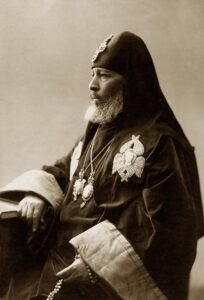Recently, on Twitter, a user named @EphraimChrist14 tweeted at our Orthodox History account, “Why are bishops not selected from those living under obedience in a monastery who have gained spiritual experience and are filled with the Holy Spirit? Is that because the bishops and patriarchs are Barlaamites and consider only admin skills and education as relevant?”
This comment — which obviously has an edge to it — raised an interesting question for me: do holy bishops, in fact, live as humble monks for an extended period of time prior to their consecration? In many quarters, this concept is held up as an ideal, but is it actually the case?
The short answer is, no, not really. I gathered information on 24 bishops from the past 200 years who have been glorified as saints, plus a couple who are widely venerated (Patriarch Pavle of Serbia and Metropolitan Leonty Turkevich). The earliest bishop on the list is St Peter of Cetinje, the Metropolitan of Montenegro, who was consecrated in 1781 and died in 1830. The most recent is Patriarch Pavle, who was consecrated in 1957 and died in 2009. Thirteen of the bishops on the list were consecrated in the 19th century, and thirteen in the 20th.
The bishop-saint with the most extensive monastic formation is undoubtedly St Gregory the Teacher of Romania, who lived from 1765 to 1834. St Gregory became a monk at age twenty-five under the great St Paisius Velichkovsky, and he later spent time on Mount Athos and in other Romanian monasteries. At the age of 58, the Prince of Wallachia summoned St Gregory — who at this point was only a hierodeacon — to become Metropolitan of Wallachia, based on his reputation for wisdom and spiritual maturity. This is the kind of path that I think a lot of people have in mind when they imagine monastic formation for future bishops, but it is very much the exception rather than the rule.
St Gregory’s younger Romanian contemporary, St Calinic of Cernica (1787-1868), had a similarly lengthy period of monastic formation. Their fellow Romanian St Joseph the Merciful of Moldavia (1820-1902) lived in a monastery from the age of ten. These three Romanian bishop-saints stand out among 19th-20th century holy hierarchs. Almost everyone else did not have such a monastic formation.
A more typical story is that of St Philaret of Moscow — he went to seminary and then to the Moscow Theological Academy, and after graduation he became a professor. Just before his 26th birthday, he was tonsured a monk and ordained a hierodeacon; a few months later, he was appointed as a seminary dean of students and then ordained a hieromonk. Soon, he was appointed abbot of a monastery; at the same time, he pursued doctoral studies. At no point was he a monk in a monastery under obedience to an abbot; he was, rather, a professor and administrator in higher theological education before climbing the ladder of church leadership further. He went on to become the most prominent and respected bishop in the Russian Orthodox Church in the 19th century. Despite his lack of typical monastic formation, he was a great lover of monasticism, particularly notable for his support of the great Optina Monastery and of Holy Trinity-St Sergius Lavra. This is a theme that seems apparent among these bishop-saints: although most of them didn’t have a “normal” monastic formation themselves, they tended to be patrons of monasticism as bishops.
Saints Benjamin of Petrograd, John Pommers of Riga, Tikhon of Moscow, and Nikolaj Velimirovic all had comparable stories to St Philaret: never really living in a monastery, but living as monks while working in higher theological education. St John Maximovitch was tonsured while studying theology at a university and worked as a teacher, but didn’t live in a monastery. St Raphael Hawaweeny was tonsured and then immediately went to the Halki Seminary to pursue theological studies; St Chrysostomos of Smyrna followed a similar path. St Nicholas of Japan was tonsured a monk and immediately ordained to the priesthood while studying at the St Petersburg Theological Academy, and almost immediately, he set off for Japan.
St Andrei Saguna, another great Romanian hierarch, had kind of a “backwards” track: he pursued theological studies and then worked as secretary to his metropolitan, but later, after becoming a hieromonk, he did live for a few years in a monastery.
St Nektarios of Aegina might be the most beloved bishop-saint in modern times; he did live in a monastery for several years, three as a novice and three more as a simple monk before becoming a hierodeacon and pursuing his education. Two other spiritual giants of modern times, St Ignatius Brianchianinov and St Theophan the Recluse, somewhat surprisingly did not have a classic monastic formation. St Ignatius tried out numerous monasteries as a novice, but he was disappointed at failing to find a suitable spiritual father, and in his later writings, he decried the lack of holy elders in his day (kind of an odd complaint considering he lived during the golden age of the Optina Elders, among others). St Ignatius was made an abbot at the age of 25 despite not having been formed as a simple monk. Then there’s St Theophan, who worked in theological education and then joined the Russian Ecclesiastical Mission in Jerusalem, becoming a church diplomat and then later a bishop. Soon enough, he retired and began the life of seclusion that earned him his moniker.
Several great bishop-saints of modern times were widowers: Innocent of Alaska, Vladimir of Kiev, Kirion of Georgia, Seraphim Chichagov, Luke of Simferopol. (Metropolitan Leonty Turkevich could be added to this list.) Understandably, these men typically did not have any monastic formation, although Vladimir of Kiev is notable for having spent about two years in a monastery between his wife’s repose and his consecration to the episcopacy.
As far as I can tell, no bishop-saint who was consecrated in the 20th century lived as a simple monk, but we might have one soon: Patriarch Pavle, the beloved primate of the Serbian Church, was in a monastery for almost a decade. Also, St Varnava Nastic, who was born in Gary, Indiana and became a confessor for the faith in Serbia, was tonsured in 1940 and then ordained a deacon; he was part of a monastic brotherhood but had an atypical experience that was disrupted by World War II.
All told, of the 26 holy bishops on the list, 18 (69%) did not have a notable period of monastic formation. Another three (Ignatius Brianchianinov, Vladimir of Kiev, and Varnava Nastic) had some small bit of monastic formation, but not what I think people typically envision. So, that’s 21 out of 26 (81%) that didn’t follow the idealized model, leaving just five — Gregory the Teacher, Calinic of Cernia, Joseph of Moldavia, Nektarios of Aegina, and Patriarch Pavle — who were formed in a monastery prior to rising up the ranks of church leadership. In fact, more of these holy bishops were widowers (6) than were simple monks (5).
***
I have to say, I was pretty shocked at these findings. I think many people would have expected the opposite, that perhaps 8/10 bishop-saints came from monasteries and 2/10 did not, rather than the other way around.
That isn’t to say that these holy bishops lacked any sort of spiritual formation — far from it. Six of them were married men, and a great number of them went through seminary and theological academy programs that were highly disciplined. All of these men were noted for their humility and asceticism and self-denial, living truly monastic lives while actively administering their dioceses. They are the best bishops in modern times, after all. But, on the whole, they didn’t come from the monasteries. A great monk will, after many years of struggle, emerge as an abbot or a geronda/starets, but with very rare exceptions, these spiritual giants have not been chosen as bishops. St Seraphim of Sarov, the Optina Elders, the holy Greek elders of recent years (Paisios, Porphyrios, Iakovos, et al), Elder Cleopa Ilie, St Gabriel of Georgia… these are the monastic giants, the men with vast experience in monasteries. They don’t go on to become bishops.
What are the implications of this? It’s kind of hard to say. It’s a dangerous thing to have a clear-cut “bishop track” — celibate clergyman / nominal monk who works in administration or academia but is never a simple monk in a monastery. This can be a source of temptation, a path for an ambitious person to pursue the episcopal office. Yes, a lot of these modern bishop-saints followed roughly that path, but how many others did the same and weren’t so holy? Careerism and ambition are unfathomably dangerous; perhaps the saintly bishops are the exceptions, the ones who somehow took that deadly path and, by God’s grace, thrived? On the other hand, could there be a wisdom in leaving good monks in monasteries and instead selecting bishops from among those celibate clergy who have shown both spiritual maturity and an aptitude for administration? I don’t know the answers, but the data from these modern saints compels these questions.



Thank you for this research and very interesting outcome, Matthew. I found it eyeopening for sure!
I dunno, I find this unsurprising, actually: the only thing I find surprising is that you were shocked, simply because I thought this conclusion obvious. Admittedly I haven’t done a deep study, but to pick an example, look at Philaret of Moscow. He was operating in an environment where the Church was quite literally a department of the state, where bureaucrats took pains to identify those who would be effective administrators (from their perspective) and elevate them to the episcopate (and then move them around like branch managers, of course).
You ask what implications we can take from this, and I have to say I think it’s practically none. 19th century Russia is very different from the situation now.
But this isn’t a 19th century Russian thing, it’s a general phenomenon across all of Orthodoxy over the past two centuries.
Sure, I was just picking a particularly–emphatic–example.
It’s my understanding that unlike in the Russian Orthodox Church not even the formalities of monastic tonsure are traditionally required in the Greek Church(es). Not sure about the practice in other autocephalous and autonomous Churches.
The recent history of episcopal consecration in the autocephalous Church of Georgia could be interesting as I remember hearing about devout married couples agreeing to separate – and accept tonsure, I believe – so the husbands could be consecrated as much-needed bishops, post-communism after the Church had regained its autocephaly from imperial Muscovy (of the Romanov and Soviet persuasions). 🙂
You maybe right. I thought they do go through the motions of tonsure. I remember an article in the Greek newspaper about the 15 (or so) celibate men that will be leading the Greek Orthoox Archdiocese. Basically a compilation of all the young priests and seminarians in the world. A commenter said he doesn’t understand how this is when there are about 25 monks at St. Anthony in Arizona alone!
the reality of the time in which we live is that the bishop is the leader of his flock. And this does not only mean spiritually, but also within the the context of the secular world in which the Church needs to function and to survive. God has given all of the intellect and skill sets that need to be honed and developed to meet these challenges. This is why I tuly believe that in today’s world there are two necessay criteria that make a successful bishop. the first is to be a widower with children. A celibate bishop has little if any comprehension as to the impact of daily life on the families under his care. They need to fit church into their buisy schedules and their lives are forced not be govened by the church, but by the environment in which they need to survive. It is only someone who has been married and has had childen, who can truly appeciate how the parish families need to navigate though the complexities of their day.
secondly he needs to have the equivalent of an executive MBA. Why? Because he needs to know how to lead, how to speak effecively and succinctly, how to nurture, how to evaluate finances, how to market, how to innovate, how to communicste. If he does not claim his market share and devise ways of nurturing his maket share, retaining his membership base, and gowing it, then his diocese will no longer exist. Being a spiritual recluse no longer fits the bill.
It is apparent that the sanctified bethren in protecting their own and their ways, refuse to recognize this reality.
I truly believe that the studies of Alexei Kindradtch indicate this failing. Our numbers are diminishing because we are insensitive to the needs of our parishioners. If the Church demands the loyality of the parishioners, then the paishioners needs and limitations need to be recognized by the Church. This is not a one way street.
Academic credentials do not cut the mustard, they only indicate that the person is book smart. It is the street smat person who survives, and in wanting our Church to survive, this must be realized.
An interesting, though probably much harder-to-answer question, would be how these numbers correspond to those for bishops in general during the same period. In other words, I wonder if it’s around 20% of all bishops from this period who came from such a monastic background. It’s probably impossible to really determine this. But one might draw very different conclusions if, say, 5% of total bishops but 20% of bishop saints came from monasteries, or, vice-versa, 40% of total bishops but 20% of bishop saints. Just a question that occurred to me as I looked at these interesting figures.
Agreed. I think this could be approximated using generally-available information, but it is obviously a bigger project.